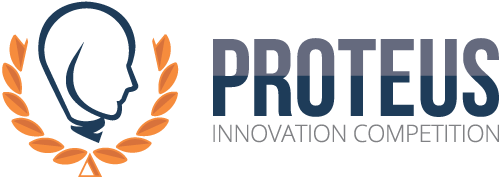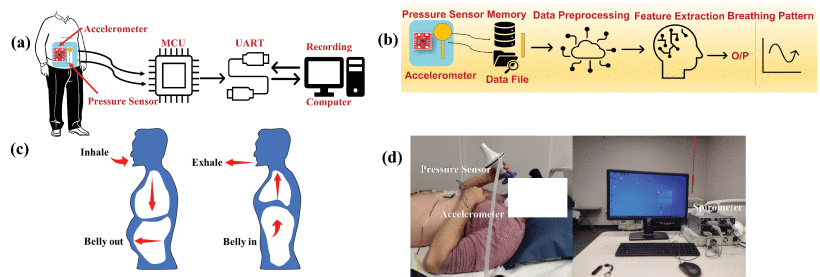Technologies 2023
2023/24 Technologies
View details from each of the five technologies by clicking on the left menu below.
- Water-Tight Composite Membranes
- Beyond Silence: App-based Peer Support for Healthcare Workers
- A Wearable Multisensor Patch for Breathing Pattern Recognition
- Bacteria-Responsive Drug Release Platform for Food Packaging
- Virtual Reality - Mental Health Crisis Response Training

Water-Tight Composite Membranes
Nanocomposite materials and its fabrication process present unique features that potentially enable water filtration by nano and/ or sub-nanopore-based membranes. Reverse osmosis (RO) is a purification process that utilizes this type of permeable membrane to remove ions, molecules and larger particles from water. The most important and by far the largest application of RO is the separation of pure water from seawater (desalination) and brackish waters. In these applications, water is pressurized against one surface of the membrane causing the transport of salt depleted water across the membrane and emergence of potable drinking water from the low- pressure side- removing both harmful contaminants present in the water, as well as some desirable minerals.
The energetic cost of purifying water by reverse osmosis (RO) is determined by the differential pressure (typically
~100 kPa) required at these two faces of a porous membrane traversed by water. Therefore, RO membranes operating at lower differential pressures are in tremendous demand for making pure water a readily available resource in many parts of the world. Thinner membranes are vital to decreasing the operating pressure of RO processes at a given water flow, hence, graphene-based and other two-dimensional materials have been identified as the ideal alternatives to existing RO membrane materials.
Tech Overview
Researchers at Western University utilized a unique method to fabricate a water-tight membrane out of sealed two-dimensional graphene flakes on a porous substrate. The resulting large-area, thin membrane enables water purification by reverse osmosis at very low differential pressures (down to 30 kPa).
Benefits
- Thin membrane produced from a single sheet of porous two-dimensional graphene material to achieve water filtration by pore-size rejection.
- Allows for very low differential pressures (down to 30 kPa), compared to 100-1,000 kPa in state-of-the-art RO methods.
Principal Investigator:
Giovanni Fanchini
Research interests: Our research interests have a common denominator in the investigation of light-matter interaction at the nanoscale (i.e., at a scale significantly smaller than a wavelength for light in the visible and near-infrared photon energy range). Our research team develops, and makes use of, advanced instrumentation [e.g., scanning near-field optical microscopy (SNOM) based on atomic-force microscopy (AFM) and/or scanning tunnelling microscopy (STM)] to investigate light-matter interaction in a host of materials of practical interest, including: organic photoactive polymers and molecules for solar cells and carbon-based nanomaterials and 2D materials for sensing and thermal management (e.g., graphene and graphene oxide). We are also equipped with facilities for the growth of these materials (sputtering, plasma reactors, chemical vapor deposition, and solution processing) as well as their incorporation into opto-electronic devices (solar cell fabrication and testing facility, and variable-temperature electrical conductivity measurement system down to 15K). Specific devices we are interested in include: photovoltaics (“solar cells”), resistive memory devices (“memristors”), resistive water-impurity sensors (“chemiresistors”) and thermal-management devices (“heat spreaders”). We are also running the only open-user electron-spin resonance / electron paramagnetic resonance (ESR/EPR) facility in London, specialized in (but not limited to) the investigation of photoactive paramagnetic centres in solar-cell materials.

Learn More: https://physics.uwo.ca/people/faculty_web_pages/fanchini.html

Beyond Silence: App-based Peer Support for Healthcare Workers
Introduction:
There is an urgent and critical need for accessible mental health services and supports for Canadian healthcare workers. Many are struggling in the aftermath of the pandemic, with high rates of anxiety, depression, moral injury and burnout. There is a staffing crisis in many healthcare settings across the country, creating barriers for timely access to healthcare services. Mobile technology can be an important part of the solution by providing accessible, on demand information and links to support, with the potential to reach a wide range of workers, including those in under-resourced settings. In addition, access to peer support through a mobile application can be a cost-effective first line approach and a conduit for professional support in a stepped model of care. Innovative solutions are needed to ensure the psychological health and safety of our healthcare workers and to ensure quality care for the millions of Canadians who rely on their services.
Technology Overview:
Beyond Silence is a mobile application platform developed by a researcher at McMaster University in order to promote earlier intervention and peer support for Canadian healthcare workers. It has been described as a “mental health coach in your pocket” customized for healthcare providers. The mobile application platform includes an m-health app for frontline healthcare workers that provides access to evidence-informed articles/videos/podcasts and infographics on topics related the mental health and well-being, self-management tools (e.g. wellness monitoring, goal setting), and anonymous, secure access to a trained peer support provider of the users choice via chat or text (7 days a week). Trained peer support providers across the country who provide services via the app, also have access to their own resources, ongoing training and clinical support. The mobile health platform includes a portal to customize content for organizations and generate data regarding patterns of app utilization and feedback regarding the peer support service.
Benefits:
- App content can be customized for organizations (articles, resources)
- Accessible via App or Google Play (with organization code to open)
- Co-designed by and for healthcare workers
- Provides anonymous, secure access to peer support
- Choice of peer support – who to reach out to/when/how (phone or text) “help is a click away”
- System for risk management of users who may be in crisis
- Supported by implementation research conducted with 8 diverse healthcare organizations
- Robust analytics portal for quality assurance and research
Principal Investigator
Sandra Moll
Sandra’s research interests relate to mental health/mental illness, along the continuum from mental health promotion to illness intervention. Her primary program of research focuses on workplace mental health, including approaches to building mental wellness and mental health literacy and reducing stigma in the context of work. Recent projects include: a provincial study of the psychosocial vulnerabilities of young workers; mental health literacy training with healthcare workers; and a study of faculty-student interactions related to mental health in post-secondary education. Other areas of interest include occupation-based approaches to health promotion and psychotherapy interventions. Her primary methodological expertise is in qualitative, participatory research.

Learn more: https://www.beyondsilence.ca/

A Wearable Multisensor Patch for Breathing Pattern Recognition
Changes in biophysical movements are among the earliest vital signals for worsening health and are the most predictive of a concerning clinical outcome for patients. Among the different biophysical parameters to detect, changes in respiration and breathing rate are particularly relevant, as variations at rest almost always indicate some form of worsening pathology. Despite the fact that the breathing rate is a relatively simple phenomenon, its detection can be tedious and often requires a long monitoring period in highly specialized laboratories or is often left to the health practitioner for manual recordings.
Technology Overview
To address the various challenges associated with monitoring breathing patterns and related biophysical patterns, the inventors have developed a multisensor wearable sensing system and method that combines one accelerometer for breathing-associated body motion sensing and one pressure sensor for breathing- associated muscle expansion and contraction detection. The sensing platform can easily be used by people through a facile and comfortable installation on the abdomen. The technology allows for rapid, efficient, and accurate real-time monitoring of complex breathing patterns without the utilization of specialized equipment or trained personnel.
Benefits
- Eliminates the need for specialized equipment for biophysical monitoring.
- Rapid and cost-effective manufacturing.
- Ease of sensor assembly and packaging.
- Robust sensitivity and sensor response time.
- Wired and wireless.
- Prolonged and remote monitoring.
- Small footprint, flexible, conformal fit and less intrusive for people to wear.
- Non-invasive monitoring system.
Principal Investigator
Associate Professor
Dr. Jalal Ahamed
519-253-3000 ext. 2682
M.Ahamed@uwindsor.ca
Office: 2145 CEI
Education
- PhD (University of Toronto)-2012
- MASc (University of Toronto)-2006
Research Interests
- Micro/nano-electromechanical (MEMS/NEMS) based sensors and actuators
- Micro/nano-fluidic based lab-on-a-chip for biological analysis
- Micro/nano-fabrication, testing and characterization
- Mechatronics and Controls
Principal Investigator

Associate Professor
Dr. Simon Rondeau-Gagné
Organic Materials
Ph.D. (Université Laval)
Simon.Rondeau-Gagne@uwindsor.ca
Associate Professor
Phone: (519)-253-3000 Ext. 3556
Fax: (519)-973-7098
375-1 Essex Hall
Research Homepage
RESEARCH AREA:
Organic Materials Chemistry
RESEARCH OVERVIEW:
In the internet-of-things era, where everyone and everything is expected to be linked and connected via wearable/flexible devices, development of new materials with enhanced stretchability and robustness is crucial. The Rondeau-Gagné research group focuses its research on the development and synthesis of new materials for the next generation of electronic devices. Throughout our research, a special emphasis is put on supramolecular chemistry and self-assembly for designing materials that can be repaired after suffering from strain and environmental damages (self-healing properties). Our research also contributes to the rise of more efficient and sustainable materials through the utilization of greener synthetic and processing methodologies.
Our group is a multidisciplinary environment where every group member learns about several aspects of materials science (organic synthesis, polymer chemistry, materials characterization, electronic devices fabrication, etc.). In specific, our research interests include:
- Synthesis and development of stretchable and self-healable polymers for the fabrication of entirely stretchable electronic devices.
- Polymer engineering through supramolecular self-assembly and crosslinking
- Bioimaging and nanomedicine using conjugated polymers nanoparticles

Bacteria-Responsive Drug Release Platform for Food Packaging
Currently, 17% of the total global food production is wasted which is due in part to the short shelf-life of food products. Preservatives are used to prevent spoilage, improve appearance, and maintain the food’s nutritional quality; however, preservatives only prolong food shelf life and do not eliminate bacteria. By the time bacteria growth is detected it is too late, and the entire food product must be discarded. Furthermore, certain preservatives may have unwanted side effects. Designing better and smarter food packaging can help prolong the shelf-life and help dramatically reduce food spoilage and promote food sustainability.
Description of the invention
This invention relates to a novel smart bacteria-responsive platform that will only release antimicrobial agents (preferably naturally derived) in the presence of specific bacteria. Common bacteria involved in food poisoning include bacillus, clostridium, listeria, and streptococcus. These bacteria produce a class of virulent factors called cholesterol-dependent cytolysins (CDCs).
Waterloo researchers have developed a nanotechnology-based formulation (liposome) that achieved sustained drug release over a 5-day period only in response to specific bacteria that produce CDCs. No drug is released in the absence of these bacteria. This is the first known on-demand bacteria- responsive technology platform.
Advantages
The platform shows high specificity of drug release to bacteria that produce CDCs which can be used to prolong the shelf-life of food products. This can reduce the use of food preservatives which may have unwanted side effects and will eliminate the bacteria responsible for food spoilage when or if it is present. This will reduce the exposure of unwanted chemicals while prolonging the shelf-life of food products.
Potential applications
- Surface coating on food packaging
- Could be extended to other systems that require the release of antimicrobial agents when certain bacteria are present:
- High-contact surfaces such as countertops
- Curtains/drapes
- Medical equipment
Principal Investigator:
Emmanuel Ho
Biography
Research Interests
- Drug delivery and pharmaceutics
- Nanomedicine, medical devices, biomaterials
- 3D Printing, hot-melt injection molding
- HIV\/AIDS, cancer, chronic wound healing
- Clinical Pharmacology
- Technology and Optics
- Drug Discovery, Design and Delivery
- Disease Detection and Modeling
- Smart Materials
- AI assisted Materials Development
- Thernostic Materials
- Biochemistry and Biophysics
- Bionanotechnology and Biosensors
- Devices and Analytical Methods
- Smart and Functional Materials
- Molecular Therapeutics and Theranostics
- Nanomaterials
- Biomaterials, Polymers and Bioplastics
Scholarly Research
Education
- CIHR/MSFHR Post-Doctoral Fellow, British Columbia Cancer Research Center
- Ph.D., University of Toronto
- Hons.B.Sc., University of Toronto

Virtual Reality – Mental Health Crisis Response Training
Mental Health Crisis Response Training (MHCRT) is a complete and comprehensive training package comprising an online curriculum, scenario-based trainings delivered in VR, and evaluation designed to train frontline police officers in enhanced de-escalation and responses to people in mental health crisis.
Background
Mental illness is a critical and increasing societal concern that is not effectively dealt with through either the healthcare or the criminal justice systems, and can lead to negative interactions and outcomes for both persons living with mental illness (PMI) and first responders who are often the first point of contact.
Appropriate training is required to allow first responders and people suffering with mental illness to achieve a better level of understanding and achieve better outcomes for all parties.
Although there have been scenario training programs in existence, there are reasons to advance a unique method of problem-based scenario. Firstly, there is widespread consensus that scenarios dedicated to mental crisis education need to be amplified, even critically, with the involvement of PMI themselves as well as clinicians and advocacy associations (Coleman and Cotton 2014a; Iacobucci 2014). Increasing opportunities for social engagements between police and those with lived experience of mental illness is a way to de-stigmatize attitudes against PMI, as stigmatized attitudes against them may result in: (1) coercive methods or physical force by officers who harbor such attitudes in their efforts to resolve a crisis (Godfredson et al. 2010), and (2) a reluctance to validate concerns and impeding the possibility of procedural fairness due to skepticism regarding the credibility of a PMI (Watson, Corrigan, and Ottati 2004).
Secondly, there is a strong argument for scenario training to be led by those experienced in problem-based scenario training as an educational method within adult learning contexts (Coleman and Cotton 2014a). Without facilitators having such experience, scenarios may offer one-sided perspectives and come with the risk of privileging the exigencies of the Mental Health Act and legal concerns at the expense of procedural justice and relational policing.
With the limitations of existing scenario-based training in mind, researchers from WLU, TMU, and UVic developed the Mental Health Crisis Response Training (MHCRT).
Benefits
- Vetted by experts across disciplines. The development of the MHCRT involved stakeholders, which included mental health clinicians, forensic psychologists, etc.
- It is intended to improve overall quality of interactions between police and PMI. PMI were involved in the design, delivery and assessment of the program, which is pivotal to reduce stigma and enhance procedural justice.
- The use of principles of Forum Theatre as a valid and effective method to increase de-escalation and mental health crisis response competencies is informed by SSHRC-funded research by the authors.
- Having been developed onto a VR platform, the MHCRT is now more portable and scalable, as it reduces the need for live actors, and can be rolled out to police services in many different areas.
- Integration of duty equipment allows a more realistic interaction within the VR scenarios.
- Stop-playback method allows trainers and trainees alike to pause and assess how the trainees handled the scenarios.
Features
The MHCRT is based on a particular form of problem-based scenario training informed by Forum Theatre methods, which have been used effectively with the Victoria Police Department and local immigrant populations to address stigmatizing attitudes (de Guevara 2016). Traditionally delivered via live action, the MHCRT has since been carefully developed onto a VR platform to take advantage of portability and integration with duty equipment, and which will eventually allow the development of new scenarios to support continuous and scalable training of police services.
The training curriculum consists of:
- online curriculum modules meant to be completed prior to going into VR headsets;
- 90-minute Forum scenarios that feature persons in crises. The Forum scenarios target learning objectives through VR immersions. These experiential learning sessions involve problem-solving and practicing key competencies using a stop-play-back method; and
- 10-minute Circuit scenarios that allow trainers to assess trainees’ skills acquisition using the proprietary assessment scale, DePICT™, which is used to measure a trainee’s demonstrated ability to effectively de-escalate and respond to a person in mental crisis.
Principal Investigator
Jennifer Lavoie,
Associate Professor,
Departments of Psychology and Criminology
Laurier University
Research Interest/ Ongoing Projects
I conduct nationally and provincially funded research focused on police interactions with people in mental health crisis. My program of work investigates the effectiveness of police de-escalation and crisis response training models, the use of co-response models, and police decision-making during encounters with citizens in mental health crises. I also explore how people with lived experience of mental illness and family carers experience and perceive police encounters during crisis. I am currently leading and working in partnership on a number of research initiatives to develop, produce and test de-escalation and crisis intervention training for frontline police officers using high fidelity, immersive virtual reality simulations.

Launch Event
Rewatch the Fall 2022 Launch Event to learn about the competition and hear from the innovators.



